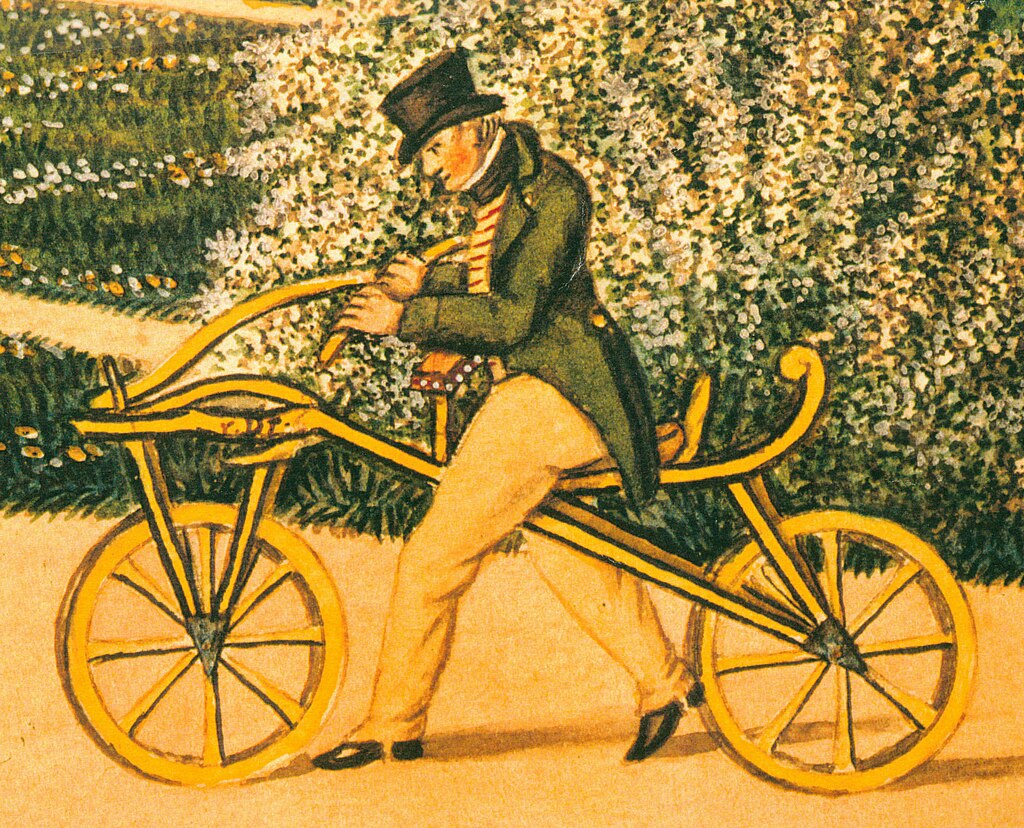How the eruption of a super volcano led to the invention of the bicycle

The bicycle is such a normal feature of our every day lives that it seems quite unremarkable, but who first had the crazy idea of balancing on two wheels?
The bicycle was invented by inventor Baron Karl Freiherr von Drais. It all started in Indonesia, on the 5th of April 1815, when the Tambora volcano erupted. Billions of tonnes of ashes were emitted into the troposphere. The ashes were transported around the world, obscuring the sun and causing crops to fail.

Due to the volcano, in the summer of 1816, harvests were so poor that people didn’t have enough to eat. People in Europe were starving and would eat whatever they could lay their hands on, including horses. With everyone eating horses, fewer horses were available to pull carriages, making transport difficult. So a German inventor, Baron Karl von Drais, tried to find a means of transport that didn’t rely on horses and experimented with modifying carriages.

Eventually Baron Drais realised that it was possible to reduce the number of wheels of a carriage, and to balance on just two wheels. He developed machine that he called a ‘running bicycle’ and tested it himself. In just over an hour he travelled 14km between Manheim and the post office in the next town. On his ‘running bicycle’ he travelled at a preposterous 13km/h! which was unheard of at that time. Baron Drais hadn’t invented pedals yet, but he pushed with his feet, much like the balance bikes you see for small children (this is why the toddler bikes are called Draisiennes).

The first bike was made out of wood and weighed 25kg
The ‘running bike,’ or ‘Draisienne’, was moderately successful, even if it weighed 25kg. But it was quite tiring to push with your feet and after a few years it fell out of favour.
However, in 1861 father and son engineers Michaux, and their assistant; ‘The German’ had the idea to add pedals to the front wheel. The addition of pedals made the bicycle more practical and allowed the rider to keep their feet off the ground. But the pedals slowed down the bicycle, as the rider’s legs could only go round so fast. To get around this problem and make the bicycle go faster, the front wheel was enlarged. And so, in around 1872, the Penny Farthing was invented. They were made out of iron instead of wood and were very dangerous as you could easily fall off the front.

We would have to wait until 1885 for English inventor John Kemp Starley to invent the pedal bike or ‘Safety Bicycle’. Starley put the seat behind the front wheel and made the front and rear wheels the same size.

In 1865 two student engineers from Lyon; the Olivier brothers, recognised the commercial potential of the bicycle. They saw the opportunity to mass produce the ‘velocipede’ (it was around this time that the English term ‘bicycle’ was also coined). The velocipede name was derived from ‘velocity’ (speed), and ‘ped’ (feet). The Oliver brothers formed a partnership with the Michaux brothers and began producing safety bikes en mass, and so began the first ‘bicycle craze‘ (1867-69).
The bicycle is made up of over 1000 pieces. In 1900 the three most complicated machines in production were the steam engine, the sewing machine and the bicycle. Sewing machine producers also made bicycles (and arms). e.g. the Saint-Étienne Weapons Factory, which also made bicycles.
The bicycle brake was invented 81 years after the bicycle
In around 1891, thanks to Dunlop and Michelin’s invention of removable rubber inner tubes, the modern bicycle was born. Before this, bicycle wheels consisted of steel with an outer layer of rubber.
We don’t always realise the ingeniousness that makes up the modern bicycle. The bicycle is the product of hundreds of patents. The diamond frame, for example, was an important invention, before this the frames were much weaker. There was also the sprung seat which made the ride more comfortable. But it wasn’t until 1897 that an American named Abram W. Duck invented the ‘duck brake’ which was a precursor to the modern bicycle brake.
‘Bicycle face’
But who used these bicycles? In 1885 a bicycle cost the equivalent of around 7,000 euros. It was expensive, but much faster than a horse and could be rode for longer without risk of killing a horse. At first the bicycle was the reserve of rich and eccentric aristocrats. It was forbidden for women to use the bicycle as it was said it would make them crazy, and besides they couldn’t ride bicycles while wearing a dress. There was even a campaign to prevent women from using the bicycle and physicians warned against female health problems and ‘bicycle face’ (‘a visage with a permanently tense and careworn expression.’)
So how did the bicycle become so popular? Over time the bicycle continued to be industrialised and by 1935 a bicycle cost the equivalent of just 700 euros (ten times cheaper than in 1885). This meant that every household could afford at least one bicycle. There were about 10 million bicycles in France before the war.
Decline of the bicycle
After WW2 manufacturers of motorised bicycles launched a marketing campaign to attract a new clientele. The Solex was advertised as ‘The bicycle that drives itself’. In the 1960s advertising companies gave free motorised bicycles to celebrities such as Johnny Halliday so that the youth of the day could see their idols riding around on motorbikes and picking up girls easily.
As motorbikes and autocars became more popular and roads became more busy and dangerous, bicycle use declined. It wasn’t until much more recently, with the introduction of traffic calming and dedicated cycle routes, e.g. Netherlands, Germany and France, that the bicycle has had a revival in popularity.
Sources:
France Bleu – L’histoire du vélo, le moyen de transport le plus utilisé au monde –
with Stéphane Dugast. Author, Economist, Director and Urbanist at the University of Lille, author of Vélo !






